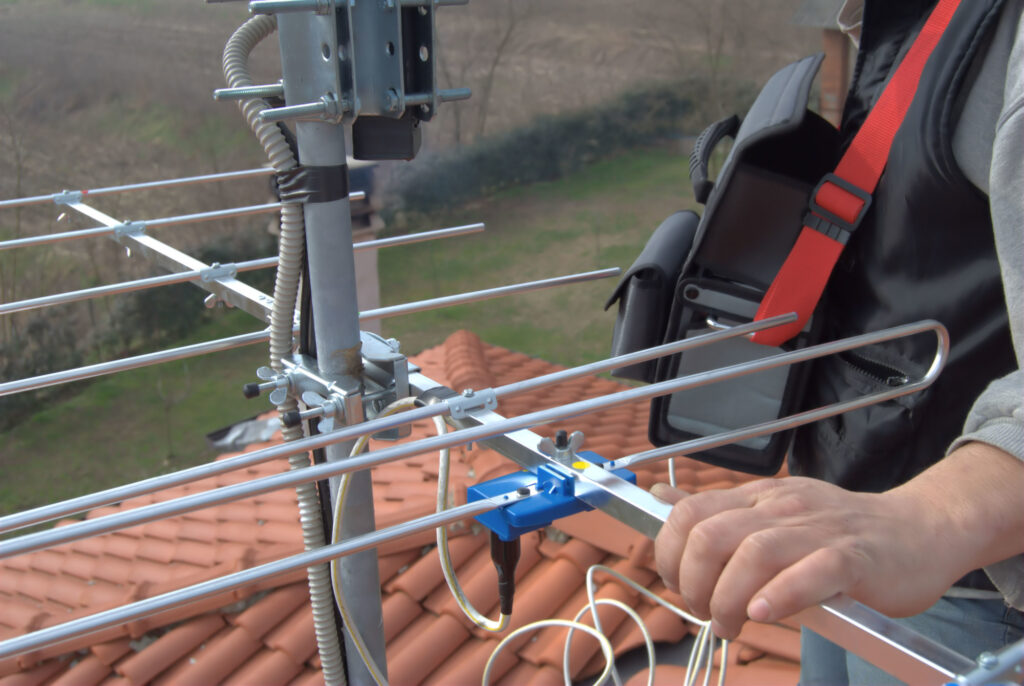
How Much Does It Normally Cost to Install a TV Antenna?
Increased cable costs have driven many TV viewers to streaming networks. Lost in the transition is the local news and events programming. Since antennas receive local programming, they are the best solution to close the gap.
Antennas are available in big-box and discount stores, but few understand what it takes to install.
Some might have DIY abilities and desire to up their skills and install a TV antenna. But there are many factors to consider during an installation that impact the TV’s reception.
Contacting a professional TV antenna installer can provide the key considerations related to your specific location. Consider selecting a technician who is a member of the ADTIA.
Also, if you need a TV antenna installation company, you should know the prices you can expect to pay. Our guide here has you covered.
TV Antenna Installation
TV antenna costs vary by area. Since there are all kinds of TV antennas, the size and type of antenna will impact the pricing. The contractor’s choice of installation equipment can also impact pricing. Other pricing impact factors include physical location and local ordinances.
This guide will simplify the factors that affect installing a TV antenna. Here are the main categories of things that will alter the pricing.
Size & Type of Antenna
The differences in brand-based setups and reception quality mandate the installation process. The higher the quality of the antenna, the more complex the installation. There are also considerations that go beyond the manufacturer’s abilities.
There are three considerations when determining the installation of a TV Antenna.
Unidirectional v. Multidirectional v. Omnidirectional
A unidirectional TV antenna must point toward the signal tower broadcasting the show a viewer intends to watch. If the antenna’s aim is off, the signal becomes distorted and unreadable.
An antenna located farther away from the signal requires less correction. To receive a strong signal in an area with several towers, the unidirectional TV antenna requires a motorized rotor. This facilitates the aiming of the antenna for a clear picture.
To find the station towers that send the TV signal, an online Transmitter-Locator can be used.
When a unidirectional TV antenna is not able to point toward its signal source, the picture becomes snowy, glitchy, and disrupted.
Multidirectional antennas do not need to point in any one direction for a clear picture but give up the crispness of the image. This simplifies having to make adjustments with each show. These antennae are smaller and may need amplification or a closer signal.
Omnidirectional antennas can be used indoors or outdoors and typically include a preamplifier to bring more clarity to the signal. These antennas are many times installed in an attic.
There are more types of antennas than listed above. Even the services list for the different kinds of TV antennas goes beyond this article. In each case, there might be other factors like a location that impact the installation.
Indoor v. Outdoor
To install a TV antenna outdoors, the mounting would place the antenna 8 ft. above the roofline. Many would consider this an eyesore. While outdoor antennas capture clear signals, many HOAs frown on such installations.
Restrictions might include antennas on roofs, tall poles, or backyard masts.
Indoor antennas come in two forms. One is the 12″ model that sits on top of a TV set or hangs on a nearby wall. The other is like an outdoor antenna in size and is installed in the attic using an amplifier. This larger TV antenna usually pulls in better signals than the smaller one.
Amplified v. Non-Amplified
Amplified antennas require an electrical source to power the boost in the signal. TV antenna boosters are good when your antenna needs to be inside an attic or located more than 20 miles from the source signal.
Non-amplified antennas are passive and limited by distance – any signal from within a 20-mile radius received with clarity.
Cable providers using signal boosters or amplifiers every mile were able to entice suburbanites away from their antennas. They provided a greater clarity of picture during storms than most antennas at the time.
Physical Location
If TV antennas have a direct line of sight to the signal tower, the surrounding terrain won’t impact the picture. But if the antenna is on the roof of a home surrounded by taller trees, the signal will deteriorate. An amplifier can boost the signal to compensate for the woodline.
The distance the signal must travel can degrade the image. When possible, an amplifier boosts the image back to its original state. Storms can also impact the quality of the signal. This happens less often since TV signals switched to digital from analog years ago.
Contractor’s Equipment
When determining the type of equipment needed to install a TV antenna, contractors consider safety and speed. For example, some contractors will opt for using a lift truck with a cage to install an antenna on a tall mast. This speeds up the installation process and is safer for the installer than using a ladder.
Other contractors will have the installer use a ladder to get to the highest point on the roof. Then the installer uses rope and repelling gear to move down to the mast area.
The rope acts as a safety line and saves on the high equipment rental cost. But this process may also slow down the worker, which increases the job cost.
How Much Does It Normally Cost to Install a TV Antenna?
After taking into consideration all the above information, installing a TV antenna will cost anywhere from $55 to $600. The national average is $308. Keep following us for more information that will help you with DIY and your household.
